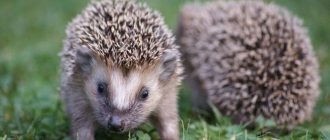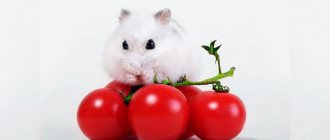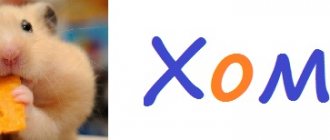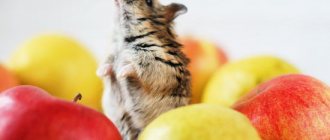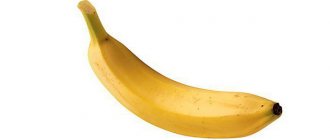To make your pet's coat look healthy and shiny (and this is one of the external signs that allows you to determine the pet's current condition), you need to feed the rodent according to the following scheme: the basis of the diet is dry food, in addition - vegetables and fruits. But here the question arises about cereals; not all of them are healthy. But today all myths will be dispelled, and answers to questions will be found.
Cereals for a hamster: what you can give and what not
Proper, nutritious and at the same time varied nutrition is the key to health and long life. And this is true not only in people, but also in animals and hamsters.
To make your pet's coat look healthy and shiny (and this is one of the external signs that allows you to determine the pet's current condition), you need to feed the rodent according to the following scheme: the basis of the diet is dry food, in addition - vegetables and fruits. But here the question arises about cereals; not all of them are healthy. But today all myths will be dispelled, and answers to questions will be found.
Possible harm from rice
In rare cases, the benefits of snow-white cereal may be ignored by the body. Harmful properties can manifest themselves in three ways:
- allergic reaction to rice;
- strong fixing effect;
- risk of developing diabetes.
If diabetes mellitus threatens humans more, then for hamsters the issue of constipation becomes relevant. Do not feed your rodent grains too often, as cracks may form in the intestinal walls and chronic constipation may develop.
Buckwheat
Buckwheat can and should be given. It is included in most grain mixtures that can be purchased at pet stores.
This product will benefit your hamster's body due to its excellent vegetable protein and nutrient content.
When deciding in what form to give this treat to your hamster, you must first assess its health. Sick rodents are usually offered porridge cooked without milk and without spices, but it is better to feed a healthy pet dry buckwheat.
Review of purchased feeds
Every pet owner is always interested in what food is best to choose for their pet. Hamsters love to eat many foods. However, for novice rodent breeders it will be useful to get acquainted with the most popular dry food.
JR Farm
This food is famous for its high protein content, which is necessary for hamsters. It contains grains, seeds, dried fruits and vegetables, as well as cheese, chicken and dried tiny fish. This composition is also rich in vitamins and probiotics, which help the pet’s digestion.
Pros:
- balanced composition;
- high protein content;
- the presence of whole wheat ears.
Consumers extremely negatively evaluate transparent and inconvenient packaging, which cannot be tightly closed to store the product. In general, this food is in greatest demand.
Fiory Criceti
This food is designed to support the immune system of a small pet. In addition to standard components, it contains peanuts, peas, fatty amino acids and organic selenium, which increases the digestibility of nutrients by the animal’s body.
Pros:
- low cost;
- convenient packaging;
- the presence of microelements that support the rodent’s immunity.
Minuses:
- minimum protein content;
- honey content is contraindicated for hamsters.
Padovan Grandmix Criceti
This food is a complete mixture for rodents. It contains grains, dried carrots, carob raisins and fortified corn.
Pros:
- affordable price;
- availability of all necessary substances.
Minuses:
- presence of dyes;
- low protein content.
Benelux Special hamster 2/1 complete mix and dessert
Premium food, famous for its unique taste and the content of all plant components necessary for a hamster’s nutrition. It ranks second among manufacturers of food for small rodents.
The biggest advantage of this product is the absence of debris and unnecessary impurities.
Minuses:
- high price;
- low protein content;
- inconvenient packaging, transparent packaging.
Vitakraft Menu Vital
Created specifically for Syrian hamsters. A distinctive feature of this product are herbal components in granules.
Pros:
- low cost;
- balanced composition;
- convenient packaging.
Minuses:
- content of honey and dyes;
- The composition of plant components in granules is useless for a rodent.
Khomka
A famous product on the Russian market. Contains all components necessary for the daily nutrition of a hamster.
Pros:
- affordable price;
- sealed packaging;
- full composition.
Minuses:
- low protein content;
- presence of dyes.
Chica-bio
Designed for feeding Djungarian hamsters. Contains Jerusalem artichoke, lean meat and birch twigs, which makes it different from other foods.
Pros:
- presence of protein;
- low cost;
- All components are crushed, so they are not capable of harming the hamster.
Animals
The food is based on plant components, contains peas, corn, cereals, and sunflower seeds, enriched with vitamins and probiotics to improve the animal’s digestion.
Pros:
- affordable price;
- quality ingredients.
Zhorka
The variety of food of this brand evokes positive impressions among consumers. Feeds come in the form of grain mixtures and granules.
Pros:
- convenient packaging;
- presence of all necessary nutritional components.
One of the disadvantages is the rather high price, although this is compensated by the quality of the products.
Kesha
This product contains Jerusalem artichoke, carob and other components included in food for hamsters.
Pros:
- low cost;
- protein content.
Minuses:
- the presence of honey and dyes;
- inconvenient packaging.
Millet and wheat
These are not the same thing, but completely different things. Wheat is a cereal, and millet is a cereal. The latter, by the way, is not recommended to be given to a hamster, since it is difficult to digest heavy food. Well, or only in an unrefined state, so that it is healthier for the intestines.
Wheat is included in any grain mixture. Moreover, sprouted to the roots, it gives the hamster incredible benefits! You can cook it yourself or buy it. You only need to offer a few roots to the rodent. Remove everything that is not eaten.
And yes, a very important point! It is better not to take wheat from the market; it can be pickled. It's better to go to a pet store.
Not just buckwheat...
Despite all the benefits, you should not switch your pet exclusively to a buckwheat diet. There is still a lot of useful and tasty things in our world. Once again, I advise you to look at the composition of purchased food - see how much there is! Don't deprive your pet of little joys. If you are not sure how much buckwheat to give your hamster, feed him a ready-made grain mixture containing this healthy grain. The composition of such mixtures is not chosen randomly. On the contrary, all the ingredients are perfectly balanced and contain everything necessary for a long, tasty life as a hamster.
Pearl barley
The product is allowed to be included in the diet - you can steam it a little, make it as for regular porridge. Just no spices or salt! The latter are very harmful, if not dangerous, for hamsters.
Pearl barley brings the same benefits to the body as buckwheat; there is nothing dangerous in this cereal. The only thing is that the hamster may not eat everything, but drag some of it into its hole. It is better to remove such deposits, otherwise the attractive delicacy will soon turn into poison.
Experienced hamster breeders do not recommend feeding your pet rice all the time, since this grain is still heavier than regular boiled buckwheat.
For young animals and in case of illness/diarrhea, rice will come in handy. But everything needs moderation, so this is more of an “on duty” option.
Other cereals
Muesli, although it is not a cereal, is still worth relating to the topic of the article. You can't give them! In addition to delicious fruits, muesli also contains sugar, the consumption of which is harmful to hamsters. These rodents cannot eat anything spicy, salty or fried. Too much sweets are also not good.
Oatmeal can and should be introduced into the diet either in the form of steamed porridge or without soaking. But if the hamster is healthy, then it is better to add a little dry oatmeal to the usual food so that the hamster chews. But the liquid version is suitable for children or those with illnesses. Sprouted oat grains (not ripening crops, but young sprouts) will be incredibly useful for a hamster, however, despite all the usefulness, the food must be balanced.
Semolina porridge will not bring great benefits to the hamster’s body, but if you decide to cook it, it is better to use water. The fact is that milk is a product that is poorly absorbed by the rodent body. It’s better not to risk it and give buckwheat (the healthiest and safest option).
Hamster's daily diet
When choosing what to feed your pet, try to ensure that the food is varied, balanced in composition, and contains vitamins.
| You can give | Not recommended | Forbidden |
| Dry food mixtures for hamsters | Food for other animals or birds | |
| Cereals | Rice (can be given only for diarrhea, well boiled beforehand) | Pasta |
| Vegetables (raw or cooked) | Potatoes, cabbage, onions, garlic | |
| Fruits | Watermelons | Citrus fruits, kiwi, mango, persimmon, pineapple |
| Greens: parsley, dill, lettuce, clover, young nettle | Sorrel, lawn grass, strong-smelling herbs and spices | |
| Sunflower, melon, pumpkin seeds | Watermelon seeds | |
| Nuts | Almonds, acorns, apricot and cherry pits | |
| Wheat sprouts, oats, alfalfa | Bread (black and white), muesli, drops for animals | |
| Legumes | Red beans | |
| Homemade dried fruits | Store-bought dried fruits | |
| Leaves and branches of deciduous and fruit trees | Needles, branches of coniferous trees |
Animal protein is necessary for complete nutrition of a rodent. It is found in the following products:
| Can | It is forbidden |
| Boiled lean chicken meat (breast) | Boiled and smoked sausages, frankfurters, sausages, lard, ham, etc. |
| Yogurt and low-fat cottage cheese (1% fat) | Cheese, sour cream, homemade cow and goat milk, butter |
| Chicken and quail eggs | Honey, ice cream, mushrooms, fruit juices |
| Boiled lean fish | |
| Grasshoppers, butterflies, mealworms purchased at a pet store | Earthworms and other worms from a flower bed or summer cottage |
| Gammarus (dry crustaceans), also sold in stores |
Do not overfeed the animal, do not put more food in the feeder than the prescribed amount. Otherwise, your pet will quickly gain excess weight. Better buy him toys and a running wheel so that he moves more and does not suffer from obesity.
If you liked the article, leave a review. Write to us what else you would like to know about your little pets.
Differences between the Djungarian hamster and the Syrian
This section was added so that the reader does not have questions about what grain each species eats.
All of the above about cereals applies to both Djungarian and Syrian hamsters, because they both differ only in a few ways:
We are what we eat. It's the same with hamsters. It is necessary to add more different cereals and fruits to the diet of a small rodent and monitor the usefulness of the food offered.
The food must be nutritious and balanced. In addition, it is necessary to calculate the dose so that the hamster does not leave large “deposits” in the house.
This whole thing is not easy, since the food on the counter does not always bring maximum benefit to the pet’s body, but the mission is feasible.
Source
Cooking food for hamsters at home
Buying special food is not the only way to feed your furry pet. What to feed hamsters at home? You can make mixtures of grains and dried fruits, feed them with cereals and fresh fruits. There are many recipes for feeding Syrian and Djungarian hamsters.
Mixture of grains “Hamster happiness”. A simple recipe where you need to calculate the ingredients and mix everything. It is very important to monitor the dosage:
- 250 gr. chopped dried apricots.
- 250 gr. dried apples.
- 250 gr. raisins
- 200 gr. pumpkin seeds.
- 100 gr. sunflower seeds.
- 400 grams of barley.
- 300 gr. buckwheat
- 400 g millet.
- 800 gr. wheat.
What cereals and in what form can be given to hamsters
Cereals play a fairly significant role in the nutrition of hamsters. They are a source of beneficial substances that have a positive effect on all systems of the animal’s body, including the immune and digestive, and even help overcome some ailments. Cereals are rich in vitamins A, E, C and group B, minerals - copper, zinc, calcium, iron, molybdenum, manganese, amino acids and fiber. However, each type should be offered to your pet in strictly limited dosages and within a certain period of time.
Buckwheat
When choosing cereals for a Djungarian or Syrian hamster, many breeders give preference to the most common and popular product - buckwheat. Buckwheat is considered one of the healthiest types of food, which not only can, but also must be included in a rodent’s diet. The product contains potassium, iron, magnesium, phosphorus, which improve blood circulation and brain activity, help strengthen the immune system, and increase the elasticity of the coat.
Buckwheat is given to your pet in three options:
Rice is considered, compared to buckwheat, to be a “heavier” product for the rodent’s digestive system, so it should be offered very rarely. In its natural form, the described cereal has a number of components valuable for health, but before it hits store shelves, it undergoes special processing, due to which it loses almost all its benefits. For this reason, feeding your pet rice is almost pointless.
Sometimes, if there are problems with the intestines, experts advise giving the hamster rice porridge pre-soaked in water for 8–10 hours, but no more than 2–3 times a week. Mostly boiled rice is used for diarrhea or for the active growth of young individuals. A medicinal rice decoction, which is given to pets several times a day instead of water, works effectively and safely and helps improve intestinal function.
Millet
Millet is one of the products that are poorly digestible by the rodent body, which experts not only do not recommend, but also prohibit giving. It is too coarse, heavy, difficult to digest, and practically devoid of nutrients. The use of millet can only worsen the pet’s health.
But wheat, on the contrary, can become a natural source of active biological components, macro- and microelements for a rodent. Cereals can be given in any form, but sprouted grains, which can be purchased at pet stores, are considered the most valuable. It is best to start introducing an animal to wheat with porridge prepared by cold brewing.
Peas
Young green peas are an excellent supplier of amino acids, phosphorus, iodine, vitamins A, E and C. They are added to the hamster’s menu for vitamin deficiency and for the treatment of cholesterol deficiency. Dzungarians prefer to eat raw pea grains, while Syrians respond better to boiled pea porridge. It is also allowed to give peas in pods or chickpeas soaked in water.
Cereals
Oatmeal often becomes one of the components of the diet of a domestic rodent.
Oatmeal is offered to pets in two forms:
You can also add sprouted oats to your pet’s menu, which are quickly digested, strengthens dental tissue and improves the condition of the hamster’s coat.
Other cereals
In addition to the cereals described above, experienced breeders advise adding to the menu of a domestic rodent:
You can also add sprouted oats to your pet’s menu, which are quickly digested, strengthens dental tissue and improves the condition of the hamster’s coat.
Useful material
Buckwheat contains many different useful substances: iron, phosphorus, potassium, calcium, copper, iodine, zinc, boron, fluorine, 18 amino acids. It contains vitamins B1, B2, B9, PP, vitamin E. Buckwheat contains a lot of protein and is a low-carbohydrate product.
Folic acid (vitamin B9) stimulates the work of red bone marrow, promotes the rapid formation, development and maturation of blood cells. Increases the body's endurance and resistance to various diseases.
What cereals can hamsters eat?
A nutritious and varied diet is the key to the health of absolutely all living creatures, including hamsters. In order for your pet’s coat to be beautiful and healthy, you need to choose the right and nutritious diet for your pet. Let's consider what cereals can be given to hamsters, whether buckwheat, rice and other cereals are suitable for them.
What to feed hamsters: allowed and prohibited foods
Syrian hamsters, Djungarians, Roborovskiy hamsters (named after the Russian naturalist V.I. Roborovskiy) and Campbell hamsters (named after the British Consul Charles W. Campbell) are suitable for home keeping.
The following depends on the conditions of keeping and diet of the hamster:
- rodent activity;
- frequency of reproduction (for females - the number of cubs born);
- pet health;
- life expectancy.
Cereals in the diet
The rodent must be fed according to the following scheme:
You can give cereals to these rodents, but you just need to know that not all of them will be useful for them. Let's consider which cereals will be useful for a rodent, and which ones are best not given.
Buckwheat
Buckwheat should be present in the diet. It is often included in prepared foods that are sold in pet stores.
Millet and wheat
Wheat is a cereal, but millet is a cereal. It is not recommended to give millet to hamsters, since their digestive system is not designed to digest heavy food. It is acceptable to give unrefined millet so that it is beneficial for the intestines.
Rice boiled and dry
Rice is a source of many beneficial substances in its natural form. It undergoes processing before entering the store, which is why it loses all its beneficial properties. Because of this, cereals are not of particular value, and it makes no sense to feed the hamster rice.
In addition, regardless of the method of preparing porridge, it is heavy for the animal’s body, and therefore can lead to digestive diseases. Be especially careful when using wild varieties of rice, as they can lead to intoxication of the animal’s body.
But if you have intestinal problems, you can carefully introduce rice porridge into your diet. Most often it is used for diarrhea, or for the successful growth of young individuals. But for this, it is recommended to feed them rice once or twice a week, using one option for preparing porridge - pre-soaking it for 7-10 hours.
But rice can be used in another form; a medicinal decoction can be made from it, which is used instead of water to treat rodents from diarrhea. It effectively helps eliminate the problem while safely affecting the digestive system.
Can hamsters eat buckwheat, millet, pearl barley and other cereals?
Proper, nutritious and at the same time varied nutrition is the key to health and long life. And this is true not only in people, but also in animals and hamsters.
To make your pet's coat look healthy and shiny (and this is one of the external signs that allows you to determine the pet's current condition), you need to feed the rodent according to the following scheme: the basis of the diet is dry food, in addition - vegetables and fruits. But here the question arises about cereals; not all of them are healthy. But today all myths will be dispelled, and answers to questions will be found.
Oats and oat flakes
Oatmeal is often included by pet owners in their diet. You can give your hamster oats in steamed form, but this should be done if you are sick or with small hamsters. Healthy animals are recommended to eat dry flakes, as they are digested faster and have a positive effect on the pet’s digestion.
Hamsters can eat oats in two forms:
- Oatmeal - rolled oats are best eaten by young hamsters, as they are softer and gentler on the pet’s digestive system.
- Oatmeal is useful for hamsters, but is not always well digested, especially with low immunity. It is recommended for hamsters to eat it boiled or soaked, as it can damage your pet’s teeth.
You can dilute the diet with sprouted oats; they are quickly absorbed and help improve the quality of teeth and wool.
Buckwheat
Buckwheat can and should be given. It is included in most grain mixtures that can be purchased at pet stores.
This product will benefit your hamster's body due to its excellent vegetable protein and nutrient content.
When deciding in what form to give this treat to your hamster, you must first assess its health. Sick rodents are usually offered porridge cooked without milk and without spices, but it is better to feed a healthy pet dry buckwheat.
LiveInternetLiveInternet
—Quote book
Learning to paint gingerbread cookies❄❄❄ To make icing, you need.
Another simple recipe for preparing eggplants for the winter is to combine them with...
Clover is popularly known by many names: trefoil, honey stalk, eryngium. .
—Categories
- 100 beauty recipes (53)
- Health (11)
- facial care (9)
- hairdresser (7)
- beautiful legs (4)
- hand care (1)
- Repair (18)
- serious crafts (8)
- Dacha (6)
- Easter (3)
- Interior (2)
- might come in handy (45)
- tasty treats (268)
- fast and tasty (34)
- cook in pots (8)
- Lenten dishes (2)
- from dough (61)
- for a picnic (17)
- dumplings (5)
- appetizer salads (49)
- salt and pickle (13)
- cakes (15)
- Embroidery (5)
- knitting (266)
- adults (8)
- kids (6)
- knitting for girls (25)
- knitting for teenagers (25)
- For yourself (12)
- useful tips (9)
- belongings (22)
- for the soul (109)
- cinema (15)
- books (4)
- crochet for beginners (17)
- New Year's (56)
- New Year's menu (19)
- Handicrafts (14)
- festive (3)
- By city and country (2)
- usefulness (60)
- useful tips (17)
- pleasantness (34)
- handicrafts (193)
- Little things in life (26)
- decoupage (17)
- For dolls (22)
- quilling (7)
- alterations (14)
- crafts (47)
- we sew ourselves (63)
- adults (6)
- for home (6)
- teenagers (2)
- Prichindals (14)
Millet and wheat
These are not the same thing, but completely different things. Wheat is a cereal, and millet is a cereal. The latter, by the way, is not recommended to be given to a hamster, since it is difficult to digest heavy food. Well, or only in an unrefined state, so that it is healthier for the intestines.
Wheat is included in any grain mixture. Moreover, sprouted to the roots, it gives the hamster incredible benefits! You can cook it yourself or buy it. You only need to offer a few roots to the rodent. Remove everything that is not eaten.
And yes, a very important point! It is better not to take wheat from the market; it can be pickled. It's better to go to a pet store.
How to cook buckwheat porridge for a hamster
We cook only with water. Milk won't do. This is too unusual and greasy a product for a hamster. I'm afraid that later he won't be able to sleep, and you'll have to clean the cage once again. In general, porridge is given to animals after illness, while they are still weakened. If your Dzhungarik or Syrian is as healthy as... And how healthy is a hamster? How's the bull? The hamster is as healthy as a bull - what's new???? In short, if your pet is 100% healthy, then it’s better to give him cereal. He grinds his teeth at the same time. If trouble happens and you just need porridge, then it’s better to just soak the cereal in water for 1 night. It will swell and soften, but will not lose its beneficial properties.
Look, he's devouring his sweet soul)))
Other cereals
Muesli, although it is not a cereal, is still worth relating to the topic of the article. You can't give them! In addition to delicious fruits, muesli also contains sugar, the consumption of which is harmful to hamsters. These rodents cannot eat anything spicy, salty or fried. Too much sweets are also not good.
Oatmeal can and should be introduced into the diet either in the form of steamed porridge or without soaking. But if the hamster is healthy, then it is better to add a little dry oatmeal to the usual food so that the hamster chews. But the liquid version is suitable for children or those with illnesses. Sprouted oat grains (not ripening crops, but young sprouts) will be incredibly useful for a hamster, however, despite all the usefulness, the food must be balanced.
Semolina porridge will not bring great benefits to the hamster’s body, but if you decide to cook it, it is better to use water. The fact is that milk is a product that is poorly absorbed by the rodent body. It’s better not to risk it and give buckwheat (the healthiest and safest option).
All about porridge
When adding porridge to your diet, consider their beneficial properties. However, what can be given to hamsters is recommended to be administered carefully to prevent your pet from having an allergic reaction. This is rare, but there is a risk of deterioration in his health.
Also, do not forget that wet mash of cereals quickly turns sour; it should be cooked before use.
Cereals can only be eaten by animals in their natural form. When preparing for use, you cannot add salt, sugar and other spices to them, or season them with oil. Milk has a negative effect on the health of hamsters, so porridge should be cooked in water.
Boiled porridge is given to weakened and sick hamsters, because in nature they do not eat it. Regularly clean the cage from the remains of porridge, as animals often take leftover food into burrows and hide them, and if they are stored for a long time, there is a risk of poisoning the animal.
Differences between the Djungarian hamster and the Syrian
This section was added so that the reader does not have questions about what grain each species eats.
All of the above about cereals applies to both Djungarian and Syrian hamsters, because they both differ only in a few ways:
We are what we eat. It's the same with hamsters. It is necessary to add more different cereals and fruits to the diet of a small rodent and monitor the usefulness of the food offered.
The food must be nutritious and balanced. In addition, it is necessary to calculate the dose so that the hamster does not leave large “deposits” in the house.
This whole thing is not easy, since the food on the counter does not always bring maximum benefit to the pet’s body, but the mission is feasible.
Source
What can you pamper hamsters with?
Give the following products to hamsters no more than once a week:
- peas and dried beans;
- peanuts, walnuts or cashews;
- live food (worms, flies, ants) - buy at a pet store;
- cheese - a piece the size of a seed. It should not be salty or contain spices - otherwise the rodent’s stomach will not digest it;
- cabbage.
Bananas can also be eaten by hamsters, but only “on special occasions” and in small quantities. Your pet's teeth are constantly growing and need to be ground down by hard food, so bananas should not be given to your pet often. Make sure your hamster doesn't hide this sweet treat, as bananas are a perishable fruit.
Considering the difficulty in digestion that dairy products (cheese, milk, eggs) and cabbage give, it is better not to give these products to a sick hamster. Replace the best ones with balanced ready-made hamster food.
